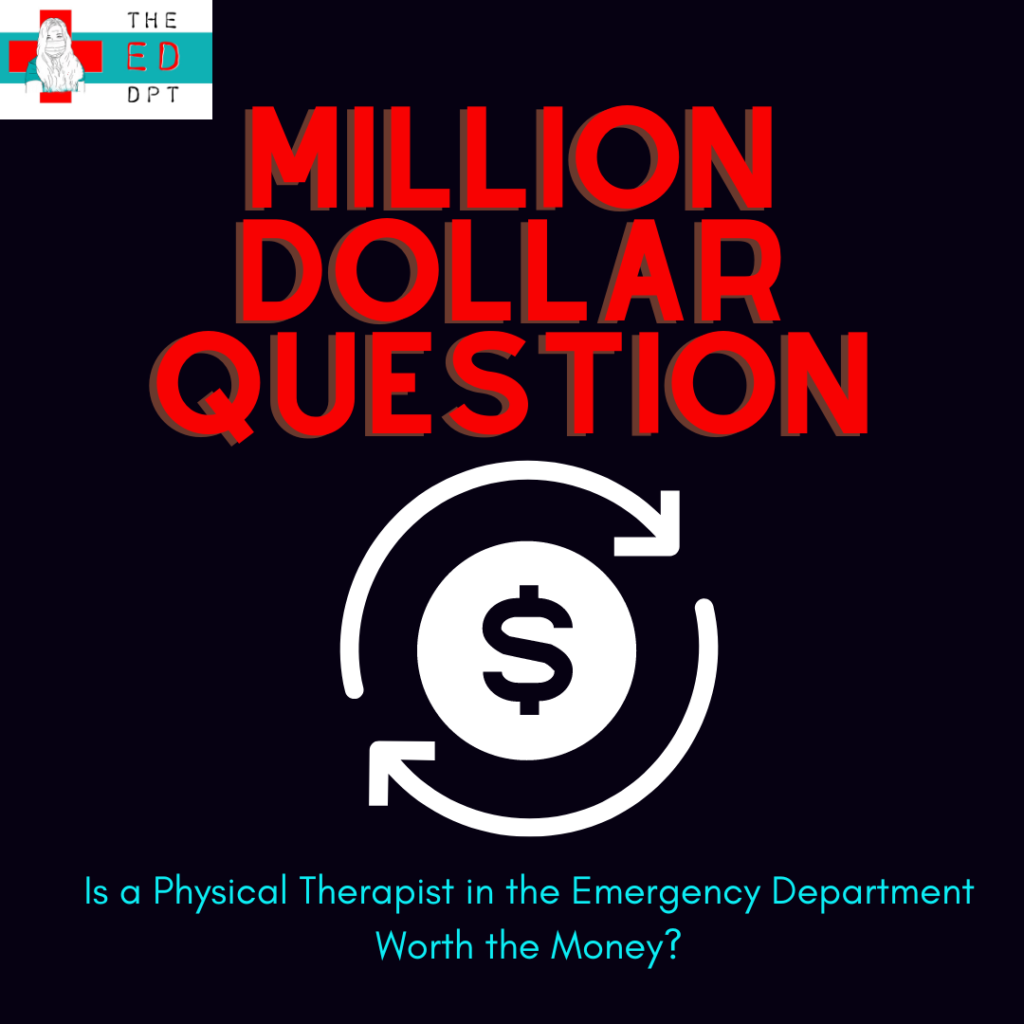Is a Physical Therapist in the Emergency Department Worth the Money?

We are often asked by therapists or managers: How can we demonstrate the financial benefit of having Physical Therapy in the Emergency Department? Unfortunately, it’s complicated. Although we can bill the patient whatever dollar amount our facility has decided upon, the actual reimbursement is typically just a fraction of that charge. So after the PT salary is covered, the hospital may earn a few dollars for the PT evaluation in the ED which hardly seems like an impressive revenue generating service for the hospital system. Turns out, that is par for the course in the Emergency Department as EDs typically are either a “money loser” for a hospital or their profit margin is relatively minimal depending on their payor mix. Meaning the actual cost of care (physician wages, nursing wages, STAT labs, STAT imaging, medical supplies, etc) in the ED is more than the reimbursement for services. Despite PT not generating much revenue, maybe we can demonstrate how PT can be worth the money if we look at the bigger picture and understand how a hospital system gets paid.
If the patient’s symptoms are managed well enough in the ED, they can discharge directly from the ED:
EDs are generally not profitable because the medical providers’ salaries are high, their STAT labs and STAT imaging requests are costly and the ED has expensive overhead costs while the reimbursement is generally not enough to cover these high costs. Average reimbursement of an ED is also lowered by the uninsured and underinsured patients who often use the ED as their primary care provider which then lowers the overall profitability of an ED.
Physical Therapy evaluations in the ED can help save costs by providing a relatively inexpensive differential diagnostic assessment and non-pharmacological intervention. A PT assessment could prevent the use of unnecessary imaging, lab work and medications which cost the hospital money. The relatively low cost of a PT evaluation and treatment and the shortened ED throughput time may lead to “less money lost” in the ED.
If the patient gets admitted to the hospital under the “Inpatient” status:
Hospitals that are registered with Medicare get paid with bundled payments for inpatients under Medicare Part A. Inpatients need to meet criteria that show they are “sick enough” or “injured enough” to need hospital care. These payments are the sum of the Hospital Base Rate + Medicare Severity Diagnosis Related Group (MS-DRG).
The MS-DRG is the dollar amount based on:
- Diagnosis
- Procedures performed
- Age/Gender
- Complications and Comorbidities
The Hospital Base Rate is unique to each hospital and is the dollar amount based on:
- Cost of Living in that hospital area (higher cost of living in that area means more money)
- Indirect Medical Education (teaching hospitals tend to spend more so they get more money)
- Average Complexity of Admissions (more complex patients means more money)
- Disproportionate Share Payments (more uninsured patients mean more money)
- Value Based Incentive Program (better outcomes and improved patient satisfaction means more money)
With bundled payments, it is in the hospital’s best interest to keep the length of stay short for any patient because the longer a patient stays in the hospital, the more of that finite bundled payment is spent on that patient’s care. So if a patient has PT in the ED, the discharge planning process starts sooner and likely would have more therapy sessions during their hospitalization which should shorten the hospital length of stay if the patient does get admitted to the hospital. Shorter length of stay means more money earned for the hospital.
If the patient stays in the hospital under the “Observation” or “Outpatient” status:
Observation or Outpatient status patients are covered by Medicare Part B because they do not meet inpatient status criteria. Medicare will only reimburse outpatient type services such as physician visits, therapy sessions, labs, imaging, etc. just like the patient would be billed in the outpatient clinic setting. This means that all other services that the hospital provides (RNs, CNAs, transport, housekeeping, meals, laundry service, pastoral care services, etc) are a cost to the hospital that will NOT be reimbursed. In summary, a hospital does not collect very much money on Observation/Outpatient status patients and therefore will essentially lose money on those patients. It is in the hospital’s best interest to not only limit the number of observation/outpatient patients in the hospital but the longer those patients are in the hospital, the more money the hospital loses as they are occupying a hospital bed that could be occupied by an “inpatient” status patient.
How can PT help? Often times, patients who present to the ED with severe musculoskeletal pain end up in the hospital under the observation status because their symptoms are not managed well enough in the ED with pharmaceuticals. If these patients could have PT in the ED, they could have their symptoms assessed and treated, often times resulting in a much improved differential assessment and symptom management in the ED. If the PT manages the symptoms well enough, the patient can discharge home directly from the ED without the costly observation stay that the hospital would like to avoid.
PTs provide valuable care which makes their ED presence worth the money by:
- Increasing the hospital base rate in the bundled payment calculation
- Improve patient satisfaction
- Improve outcomes
- Decrease re-visits to the ED
- Prevent complications (DVT, hospital acquired pneumonia, skin integrity complications, etc)
- Prevent unnecessary use of opioids and other medications
- Less money lost
- Shorten hospital length of stay of both inpatients and observation patients
- Shorten ED throughput
- Decrease number of observation patients
- Prevent unnecessary imaging and labwork
- Increasing downstream revenue
- Referrals to outpatient PT clinics
- Referrals to home health PT
Conclusion
Ultimately, it is very difficult to calculate the exact financial benefit of utilizing a PT in the ED. Loss prevention is nearly impossible to calculate and so instead, it is important to focus on how PTs can assist with “losing less money” so that the hospital can be more profitable. Based on the quality of care that PTs provide and the unique diagnostic lens they bring to the medical team, having PTs in the ED is most certainly worth the money.
- Lebec MT, Jogodka CE. The physical therapist as a musculoskeletal specialist in the emergency department. Journal of Orthopaedic & Sports Physical Therapy. 2009;39(3):221-9.
- Magel, J., Kim, J. J., Fritz, J., Freburger, J., M, F. J. (2020). Time Between an Emergency Department Visit and Initiation of Physical Therapist Intervention: Health Care Utilization and Costs. In 1782 Physical Therapy (Vol. 100). https://academic.oup.com/ptj/article/100/10/1782/5849061
- Pugh, A., Roper, K., Magel, J., Fritz, J., Colon, N., Robinson, S., Cooper, C., Peterson, J., Kareem, A., & Madsen, T. (2020). Dedicated emergency department physical therapy is associated with reduced imaging, opioid administration, and length of stay: A prospective observational study. PLoS ONE, 15(4). https://doi.org/10.1371/journal.pone.0231476
- Rimler SB, Gale BD, Reede DL. Diagnosis-related Groups and Hospital Inpatient Federal Reimbursement. Radiographics. 2015. https://doi.org/10.1148/rg.2015150043
- www.cms.gov


I would also add anecdotally that it increases the physician satisfaction, as they can offer a specialty service to their patients. Believe it or not they do get tired of pushing pills and medical-based interventions!
Definitely agree!
As Mr. Stephen said, this is often correct. EDs are generally not profitable because medical providers’ salaries are high; this can be another major reason.